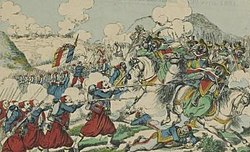French conquest of Tunisia
| French conquest of Tunisia | |||||||
|---|---|---|---|---|---|---|---|
| Part of the Scramble for Africa | |||||||
 Capture of Tunis in October 1881 | |||||||
| |||||||
| Belligerents | |||||||
|
|
| ||||||
| Commanders and leaders | |||||||
|
|
| ||||||
| Strength | |||||||
| 28,000 men | Unknown | ||||||
The French conquest of Tunisia occurred in two phases in 1881: the first (28 April – 12 May) consisting of the invasion and securing of the country before the signing of a treaty of protection, and the second (10 June – 28 October) consisting of the suppression of a rebellion. The
Context
Early contacts
Colonial competition
Following the
The French wished to take control of Tunisia, which neighboured their existing colony of
Occupation
On 28 April 1881, 28,000 men under General Forgemol de Bostquénard entered Tunisia. On 1 May, the city of Bizerte surrendered to the 8,000 men of Jules Aimé Bréart, who then continued to Tunis.[6]
Bréart entered Tunis between May 3 and May 6, 1881. He had in his possession the

An insurrection soon broke out in the south on 10 June 1881, and then in Sfax. Six ironclads were dispatched from Toulon (Colbert, Friedland, Marengo, Trident, Revanche, Surveillante) to join the French Navy ships in Tunisian waters. In Sfax, three ironclads from the Division of the Levant were already present (Alma, Reine Blanche, La Galissonnière), together with four cannon boats.[6] Sfax was bombarded, and on 16 July the city was invested after hard fighting, with 7 dead and 32 wounded for the French.[6] At Kairouan 32,000 men, 6,000 horses and 20,000 tons of supplies and material were landed. Kairouan was taken without a fight on 28 October 1881.[6]
Consequences
Great Britain and Germany silently approved the invasion of the country, while Italy protested in vain.[5]
Tunisia thus became a
Italy would respond with the 1911–12 Italo-Turkish War leading to the Italian occupation of Libya.[citation needed]
See also
- History of French-era Tunisia
- French conquest of Algeria
- French conquest of Morocco
Notes
- ^ a b c Aldrich 1996, p. 29.
- ISBN 9004097961, archivedfrom the original on 2014-05-02.
- ^ Aldrich 1996, p. 28.
- ^ ISBN 9780521228039, archivedfrom the original on 2014-01-11.
- ^ a b c d e f Aldrich 1996, p. 30.
- ^ a b c d e f Randier 2006, p. 395.
Bibliography
- Aldrich, Robert (15 Sep 1996), Greater France: a history of French overseas expansion, European Studies, Basingstoke-London: Palgrave Macmillan, ISBN 978-0-312-16000-5
- Randier (2006), La Royale, Babouji, ISBN 2-35261-022-2.
External links
 Media related to French conquest of Tunisia at Wikimedia Commons
Media related to French conquest of Tunisia at Wikimedia Commons



